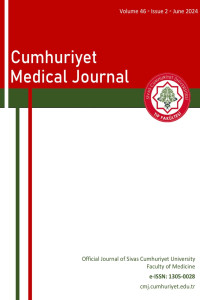Abstract
Amaç: Obezite ve agresif prostat kanseri, yaygın olması ve obezitenin prostat kanserinin agresifliğini artırması nedeniyle iki önemli klinik durumdur. Bu çalışmada amacımız, Ga-68 PSMA PET/BT yapılan hastalarda tanı anında obezite oranlarını araştırmaktı. Yöntem: Bu çalışmaya yeni tanı almış prostat kanseri olan ve evreleme amacıyla 2021-2022 yılları arasında Ga-68 PSMA PET/BT yapılan 104 hasta dahil edildi. Hastaların PET/BT çekimi öncesi rutin olarak kaydedilen boy ve kiloları ile patoloji sonuçları ve PSA değerleri Nükleer Tıp hasta dosyalarından elde edildi. [mass (kg) / height2 (m)] formülü Vücut kitle indeksi (VKİ) hesaplamada kullanıldı. Hastaların PSA değerleri ve Gleason skoruna göre intermediate ve yüksek riskli hastalar çalışmaya dahil edildi. Bulgular: Tanı anında hastaların median yaşı 70.5 (range:40-87 yaş) idi ve tanı anında 67 hasta (%64.4) metastatikti. Hastalardan 15’i (%14.4) orta risk grubunda ve 89’u (%85.6) yüksek risk grubunda idi. Hastalardan 33’ü (%31.7) normal kilolu, 45’i (%43.3) fazla kilolu ve 26’sı (%25) obezdi. Prostat kanser risk grupları ile VKI arasında anlamlı fark bulunmadı (p=0.126) Sonuç: Sonuç olarak, çalışmamızdaki hastalardan büyük çoğunluğunun kilosu normalin üzerindeydi. Bununla birlikte kilolu ve obez olmakla prostat kanser risk grupları arasında anlamlı farklılık bulunmadı. Ancak tüm literatür bilgileri de dikkate alındığında, fazla kilolu olmanın kanser riskini artırdığı göz önünde bulundurularak beslenme alışkanlıklarına dikkat edilmelidir.
Keywords
References
- Bray F, Ferlay J, Soerjomataram I, et al. Global cancer statistics 2018: GLOBOCAN estimates of incidence and mortality worldwide for 36 cancers in 185 countries. CA Cancer J Clin, 2018; 68: 394-424.
- Zorlu F, Divrik RT, Eser S, Yorukoglu K. Prostate cancer incidence in Turkey: an epidemiological study. Asian Pac J Cancer Prev, 2014:15 (21), 9125-9130.
- Bouchelouche K, Turkbey B, Choyke P.L. PSMA PET and Radionuclide Therapy in Prostate Cancer.
- Fendler WP, Eiber M, Beheshti M, Bomanji J, Ceci F, Cho S, et al. 68Ga-PSMA PET/CT: Joint EANM and SNMMI procedure guideline for prostate cancer imaging: version 1.0. Eur J Nucl Med Mol Imaging. 2017;44(6):1014-1024.
- NCCN Guidelines Prostate Cancer V.1.2022 – Meeting on 06/28/21.
- Cerci JJ, Fanti S, Lobato EE, Kunikowska J, Alonso O, Medina S, et al. Diagnostic Performance and Clinical Impact of 68Ga-PSMA-11 PET/CT Imaging in Early Relapsed Prostate Cancer After Radical Therapy: A Prospective Multicenter Study (IAEA-PSMA Study). J Nucl Med. 2022; 63:240–247
- Wolin KY, Carson K, Colditz GA. Obesity and cancer. The Oncologist. 2010;15:556–565.
- Freedland SJ, Platz EA. Obesity and Prostate Cancer: Making Sense out of Apparently Conflicting Data. Epidemiol Rev. 2007;29:88–97.
- Allott EH, Masko EM,Freedland SJ. Obesity and prostate cancer: weighing the evidence. European Urology. 2013,63(5):800-809.
Abstract
Objective: Obesity and aggressive prostate cancer are two important clinical conditions because of the prevalence and obesity increases the aggressiveness of prostate cancer. In this study, our aim was to investigate obesity rates at the time of diagnosis in patients who underwent Ga-68 PSMA PET/CT. Methods: 104 patients with newly diagnosed prostate cancer who underwent Ga-68 PSMA PET/CT between 2021 and 2022 for staging were included in this study. The patients' height and weight, pathology results and PSA values, which were recorded routinely before PET/CT, were obtained from Nuclear Medicine patient files. The formula [mass (kg) / height2 (m)] was used to calculate the body mass index (BMI). According to the PSA values and Gleason score of the patients, intermediate and high-risk patients were included in the study. Results: The median age of the patients was 70.5 (range:40-87 yrs) at the time of diagnosis and 67 (64.4 %) patients had metastases at the time of diagnosis. Of the patients, 15 (14.4%) were in the intermediate risk group and 89 (85.6%) were in the high risk group. Of the patients, 33 (31.7%) were normal weight, 45 (43.3%) were overweight, and 26 (25%) were obese. There was no significant difference between prostate cancer risk groups and BMI (p=0.126) Conclusion: As a result, the weight of the majority of the patients in our study was above normal. However, there was no significant difference between overweight and obese and prostate cancer risk groups. However, considering all the literature information, being overweight increases the risk of cancer, and attention should be paid to dietary habits.
Keywords
References
- Bray F, Ferlay J, Soerjomataram I, et al. Global cancer statistics 2018: GLOBOCAN estimates of incidence and mortality worldwide for 36 cancers in 185 countries. CA Cancer J Clin, 2018; 68: 394-424.
- Zorlu F, Divrik RT, Eser S, Yorukoglu K. Prostate cancer incidence in Turkey: an epidemiological study. Asian Pac J Cancer Prev, 2014:15 (21), 9125-9130.
- Bouchelouche K, Turkbey B, Choyke P.L. PSMA PET and Radionuclide Therapy in Prostate Cancer.
- Fendler WP, Eiber M, Beheshti M, Bomanji J, Ceci F, Cho S, et al. 68Ga-PSMA PET/CT: Joint EANM and SNMMI procedure guideline for prostate cancer imaging: version 1.0. Eur J Nucl Med Mol Imaging. 2017;44(6):1014-1024.
- NCCN Guidelines Prostate Cancer V.1.2022 – Meeting on 06/28/21.
- Cerci JJ, Fanti S, Lobato EE, Kunikowska J, Alonso O, Medina S, et al. Diagnostic Performance and Clinical Impact of 68Ga-PSMA-11 PET/CT Imaging in Early Relapsed Prostate Cancer After Radical Therapy: A Prospective Multicenter Study (IAEA-PSMA Study). J Nucl Med. 2022; 63:240–247
- Wolin KY, Carson K, Colditz GA. Obesity and cancer. The Oncologist. 2010;15:556–565.
- Freedland SJ, Platz EA. Obesity and Prostate Cancer: Making Sense out of Apparently Conflicting Data. Epidemiol Rev. 2007;29:88–97.
- Allott EH, Masko EM,Freedland SJ. Obesity and prostate cancer: weighing the evidence. European Urology. 2013,63(5):800-809.
Details
| Primary Language | English |
|---|---|
| Subjects | Health Care Administration |
| Journal Section | Research Article |
| Authors | |
| Publication Date | June 29, 2024 |
| Acceptance Date | May 14, 2024 |
| Published in Issue | Year 2024 Volume: 46 Issue: 2 |

